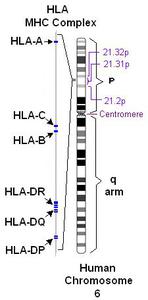Chromosome Mapping

Chromosome mapping is the assignment of genes to specific locations on a chromosome. A gene map serves many important functions and is much like understanding the basic human anatomy to allow doctors to diagnose patients with disease. A doctor requires knowledge of where each organ is located as well as the function of this organ to understand disease. A map of the human genome will allow scientist to understand where genes are located so that its function within the human genome can be elucidated. A detailed chromosome map also provides methods to study how genes are segregated and how genetic heterogeneity (variation between a particular gene maternally inherited and the same gene with a slightly different sequence that is paternally inherited) can help identify disease genes. Gene mapping can provide clinicians with useful information regarding genes that are linked, or segregate closely together.
Scientists use several methods to map genes to the appropriate locations. These methods include family studies, somatic cell genetic methods, cytogenetic techniques, and gene dosage studies. Family studies are used to determine whether two different genes are linked close together on a chromosome. If these genes are linked, it means they are close together on the same chromosome. Additionally, the frequency with which the genes are linked is determined by recombination events (crossing over of the chromosomes during meiosis) between known locations or markers, and determines the linear order or genetic distance. In somatic cell genetic methods, chromosomes are lost from a special type of cell and the remaining chromosome that has one gene, but not a different gene, would suggest that they are located on different chromosomes. This method allows scientists to identify which chromosome contains the gene, and represents one of the first mapping methods used by scientists.
Cytogenetic techniques refer to utilization of karyotype preparations, a technique that allows scientists to visualize of chromosomes, using fluorescence so that a fluorescently-labeled gene will reveal where the gene is found on the chromosome. Gene dosage studies uses, for example, numerical abnormalities to determine indirectly the location of the gene on a chromosome. In Down syndrome, there can be three chromosome number 21 (Trisomy 21), resulting in three copies of the gene and therefore, three times as much protein. In this case, a gene can be localized to chromosome 21 if there is three times as much protein in a cell with three 21 chromosomes. In this method, the amount of deoxyribonucleic acid (DNA) is assumed to be directly proportional to the amount of protein.
Using these methods, various maps of chromosomes can be developed. These maps are called cytogenetic maps, linkage maps, physical maps, or a DNA sequence map. A cytogenetic map uses bands produced by a dye that stains chromosomes in a karyotpe and assigns genes to these bands. A linkage map, also referred to as a genetic map, orders genes along the DNA strand based on recombination frequency. Linkage mapping involves using two characteristics (and hence their responsible genes), both of which are present in one parent, combined with the frequency in which they occur together in the offspring to construct the map. For example, the Moravian-born Augustinian monk and science teacher Gregor Johann Mendel (1823–1884) studied the flower color and plant height of peas. He found that various heights were observed just as frequently with white flowers as with other colored flowers and similarly, dwarf plants occurred just as frequently with the two flower types. Mendel concluded that the forms of the two genes were transmitted from parent to offspring independently of each other. This later became known as the Law of Independent Assortment, a concept that enhanced chromosome mapping techniques. A physical map orders genes or markers along the DNA strand of a chromosome. Finally, a DNA sequence, strung together, is the most precise type of map in that it contains both coding (gene-containing) and noncoding DNA. It is felt that obtaining the complete DNA sequence from the genome of many different organisms will provide scientists with vital information that will unlock many biological mysteries.
Resources
Books
Friedman, J., F. Dill, M. Hayden, and B. McGillivray. Genetics. Maryland: Williams & Wilkins, 1996.
Wilson, G.N. Clinical Genetics: A Short Course. New York: Wiley-Liss, Inc., 2000.
Other
The National Health Museum. <http://www.accessexcellence.org/AB/BC/Gregor_Mendel.html>. (October 28, 2002).
Brian Cobb
Additional topics
Science EncyclopediaScience & Philosophy: Chimaeras to Cluster